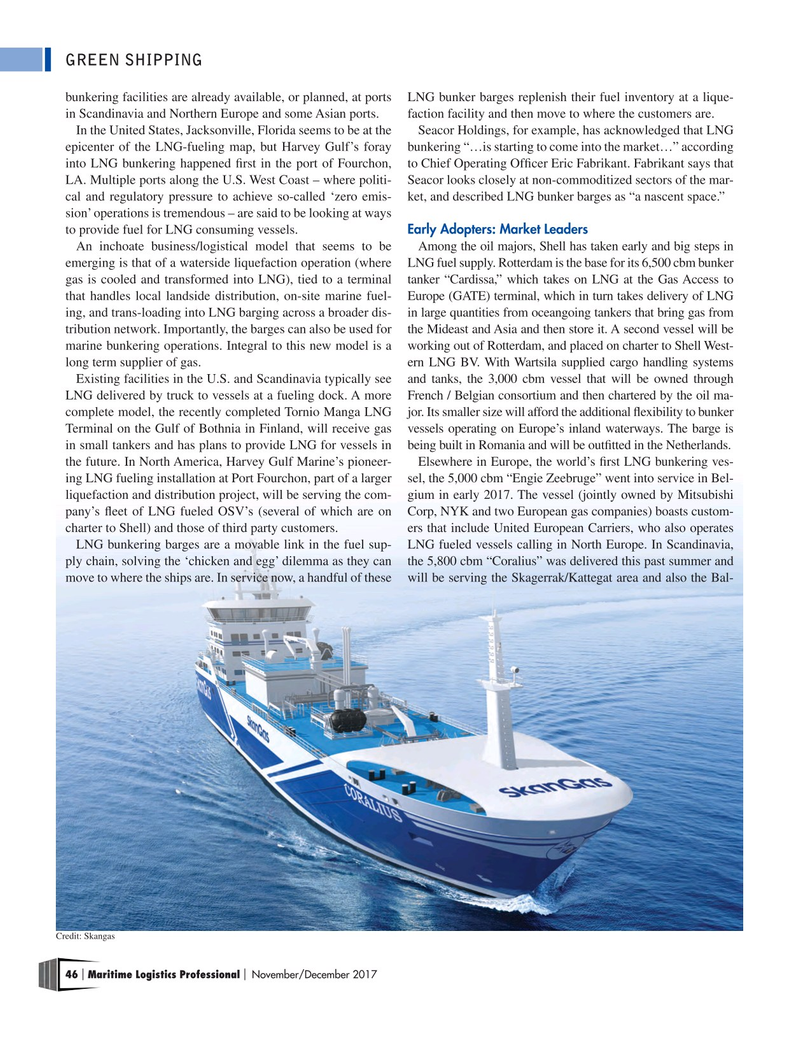
Page 46: of Maritime Logistics Professional Magazine (Nov/Dec 2017)
GREEN PORTS
Read this page in Pdf, Flash or Html5 edition of Nov/Dec 2017 Maritime Logistics Professional Magazine
GREEN SHIPPING bunkering facilities are already available, or planned, at ports LNG bunker barges replenish their fuel inventory at a lique- in Scandinavia and Northern Europe and some Asian ports. faction facility and then move to where the customers are.
In the United States, Jacksonville, Florida seems to be at the Seacor Holdings, for example, has acknowledged that LNG epicenter of the LNG-fueling map, but Harvey Gulf’s foray bunkering “…is starting to come into the market…” according into LNG bunkering happened frst in the port of Fourchon, to Chief Operating Offcer Eric Fabrikant. Fabrikant says that
LA. Multiple ports along the U.S. West Coast – where politi- Seacor looks closely at non-commoditized sectors of the mar- cal and regulatory pressure to achieve so-called ‘zero emis- ket, and described LNG bunker barges as “a nascent space.” sion’ operations is tremendous – are said to be looking at ways to provide fuel for LNG consuming vessels. Early Adopters: Market Leaders
An inchoate business/logistical model that seems to be Among the oil majors, Shell has taken early and big steps in emerging is that of a waterside liquefaction operation (where LNG fuel supply. Rotterdam is the base for its 6,500 cbm bunker gas is cooled and transformed into LNG), tied to a terminal tanker “Cardissa,” which takes on LNG at the Gas Access to that handles local landside distribution, on-site marine fuel- Europe (GATE) terminal, which in turn takes delivery of LNG ing, and trans-loading into LNG barging across a broader dis- in large quantities from oceangoing tankers that bring gas from tribution network. Importantly, the barges can also be used for the Mideast and Asia and then store it. A second vessel will be marine bunkering operations. Integral to this new model is a working out of Rotterdam, and placed on charter to Shell West- long term supplier of gas. ern LNG BV. With Wartsila supplied cargo handling systems
Existing facilities in the U.S. and Scandinavia typically see and tanks, the 3,000 cbm vessel that will be owned through
LNG delivered by truck to vessels at a fueling dock. A more French / Belgian consortium and then chartered by the oil ma- complete model, the recently completed Tornio Manga LNG jor. Its smaller size will afford the additional fexibility to bunker
Terminal on the Gulf of Bothnia in Finland, will receive gas vessels operating on Europe’s inland waterways. The barge is in small tankers and has plans to provide LNG for vessels in being built in Romania and will be outftted in the Netherlands.
the future. In North America, Harvey Gulf Marine’s pioneer- Elsewhere in Europe, the world’s frst LNG bunkering ves- ing LNG fueling installation at Port Fourchon, part of a larger sel, the 5,000 cbm “Engie Zeebruge” went into service in Bel- liquefaction and distribution project, will be serving the com- gium in early 2017. The vessel (jointly owned by Mitsubishi pany’s feet of LNG fueled OSV’s (several of which are on Corp, NYK and two European gas companies) boasts custom- charter to Shell) and those of third party customers. ers that include United European Carriers, who also operates
LNG bunkering barges are a movable link in the fuel sup- LNG fueled vessels calling in North Europe. In Scandinavia, ply chain, solving the ‘chicken and egg’ dilemma as they can the 5,800 cbm “Coralius” was delivered this past summer and move to where the ships are. In service now, a handful of these will be serving the Skagerrak/Kattegat area and also the Bal-
Credit: Skangas 46 Maritime Logistics Professional November/December 2017 | |

 45
45

 47
47
